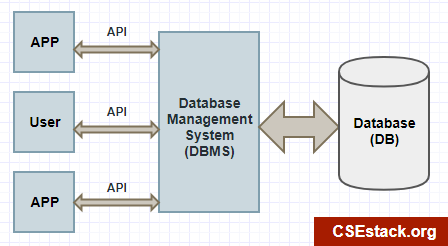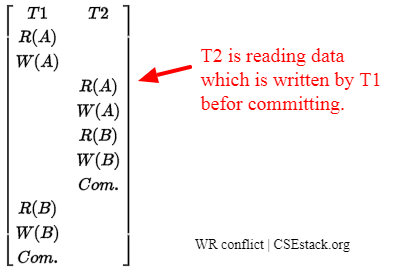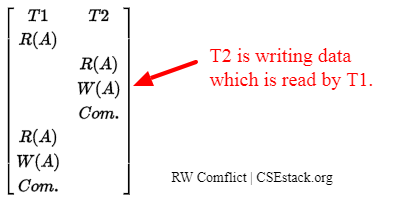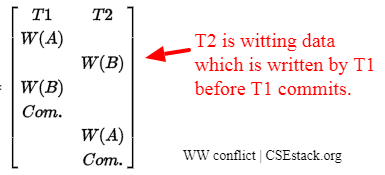![3 Different Types of Read Write Conflict in DBMS [Explained with Example]](https://www.csestack.org/wp-content/uploads/2017/08/Difference-Between-Database-and-Database-Management-System.png)
What is the Read-Write conflict in the database? Why does it occur in the DBMS (Database Management System)?
Data is crucial for any project. Text data required for the project can be saved in a file or in any reliable database. Days are gone when we were using the text files system to save the data.
In a database management system (DBMS), data is saved in the database. There are many advantages of using a DBMS system over a file system.
In this article, we will see all the different types of read-write conflict in DBMS.
Table of Contents
Data is saved into the database. To fetch and write data from the database, you need to perform read-and-write operations on the data.
There are multiple entities (multiple users, multiple APPs, multiple websites…) performing these operations on the same data simultaneously.

Just as an instance, there is a centralized banking database where all the information about the users and the bank-related information is saved.
There might be multiple user logins to their bank account and access the same bank information at the same time. They perform various operations like reading, updating or deleting the data.
So basically there are two types of operations that can be performed on the database.
Read the data value from the database. It is a safe operation, as it does not update any information in the database.
It writes data into the database and saves it for further use. After writing data, data has to be committed (Commit Operation) to making updated information available for further operations. This operation is more prone to vulnerability as it involves modifying database information.
For a data update operation, it involves both reading and writing operations.
The set of these multiple operations/instructions (to accomplish a particular task) are performed on the data. This set is called a Transaction.
Every entity accessing data holds different transactions and all the transactions execute simultaneously.
The operations involved in the successful Transaction:
Performing these operations by the different users on the same data at the same time may create data conflict. As like, accessing data by one transaction before committing another transaction does not hold well and gives data conflict.
There are different types of data conflict that happens during reading and writing operations called “Read-Write conflict”.
As I mentioned it earlier, the read operation is safe as it does not modify any information. So, there is no Read-Read (RR) conflict in the database.
Any number of transactions are free to read the same data (without conflict) anytime as long as there is no write operation.
So, there are three types of conflict in the database transaction.
Let’s see one-by-one with the example.
This conflict occurs when a transaction reads the data which is written by the other transaction before committing.
In the following diagram, I am using the following notions
A, B - two different data objects from database T1, T2 - two different transactions R(A) - reading data A W(A) - Writing data A Com. - committing transaction

Here, the transaction T2 is reading the data which is written by the T1 before T2 commits. It is also called a Dirty Read.
It violates the ACID property of the data consistency rule.
Expected behavior:
The new transaction (says T2) should not read the value of any other transaction (say T1) that already has written the data and has not committed.

Transaction T2 is Writing data which is previously read by transaction T1.
Here if you look at the diagram above, data read by transaction T1 before and after T2 commits is different.
Example:
Suppose Alice and Bob want to book a flight for their vacation. Alice opened the airline’s website to check the availability and cost of the ticket. There is only one ticket available. Alice finds it expensive and looks for other airline fares if she gets any offers.
Meanwhile, Bob logged in to the same airline portal and booked the ticket. Now, there is no more flight ticket available.
Alice does not find any good offers on other airline portals, she comes back to the previous airline portal. And tried to book a flight ticket even though it was not available. Its Conflict, Read-Write (WR) conflict.

Here Transaction T2 is writing data that is already written by other Transaction T1. T2 overwrites the data written by T1. It is also called a blind write operation.
Data written by T1 has vanished. So it is a data update loss.
Example:
Alice and Bob share a common Google sheet online. Both read the file. Alice updates the document and forgets to save the file. On another end, Bob updates the Google sheet and saves the file.
The content updated by Alice is overwritten by Bob. The data updated by Alice is lost. It is called a Write-Write (WW) conflict.
This is all about different types of read-write conflicts in DBMS. If you have any doubts or any thought about this article, write a comment below. I will reply to you back as soon as possible.
I learned about it in my database class first. It makes so easy for you to explain this topic. Thanks, Aniruddha!
You’re welcome, Betty!
Please add some real-time examples that make it more appropriate and can be used by students during exams.
Thanks, Vidya for your suggestion. Agree. I’m taking note of it and will update this tutorial by adding some examples.
Hi.
You might wanna change the image of WW conflict. The first action of T1 should be W(B). Else you might wanna exchange T1 and T2 in the description. Best!
Hi Sheron,
Thanks for that correction.
Thank you so much, bro. I understood the concepts very well with the help of examples.
You’re welcome, Loki!
Sir… This is the best content I have seen till now.
Great content sir. I am preparing for gate this is very useful for me to brush up on all my concepts.
Sir, I have a doubt regarding the conflict operation. Where can I post it, sir? please clear me this doubt I am confusing about that for a long time. I hope it will clear for me now. Thank you sir.
Dheeraj, I’m glad this article helped you with your GATE preparation. You can always ask me the questions in the comment section. We also have a Facebook group for GATE preparation if you would like to join.
Thank you, sir. But here I can’t upload any pic or images to ask the doubt, sir.
You can join our Facebook group and share. Or you can also drop me an email at
[email protected]Thank you sir .I will post my doubt in your email. Thank you so much sir
Sir, I posted my doubt to your email. Can you please sort it out? Help me sir.
Sure. Will respond to your email very soon.
Thanks a lot!!
You’re welcome!
<3